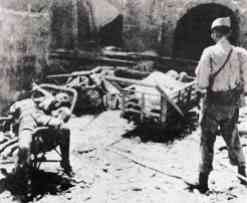
The Manila massacre involved atrocities committed against Filipino civilians in the city of Manila, Philippines by Japanese troops during the World War II Battle of Manila (February 1945). The Manila massacre was one of several major war crimes committed by the Imperial Japanese Army, as judged by the postwar military tribunal. The Japanese commanding general, Tomoyuki Yamashita, and his chief of staff Akira Mutō, were held responsible for the massacre and other war crimes in a trial in late 1945 in Manila. Yamashita was executed on 23 February 1946 and Muto on 23 December 1948.
Prior to the battle, deciding that he would be unable to defend Manila with the forces available to him, and to preserve as large a force as possible to continue defensive operations in the rural mountain Luzon region of the Philippines, General Tomoyuki Yamashita had insisted on a complete withdrawal of Japanese troops from Manila in January, 1945. However, Yamashita’s order was ignored by approximately 10,000 Japanese marines under Rear Admiral Iwabuchi Sanji who chose to remain in Manila.

Approximately 4000 Japanese army personnel were unable to leave the city due to the advance of the American and Filipino forces.
The envy of other Far Eastern cities before the war, lovely Manila, a melting pot of four cultures and the acknowledged Pearl of the Orient, turned completely to rubble and smoldering ash, wrack and ruin in the 28 days it gasped its last. Its face changed forever, national as well as city administrators since then have barely seen to its proper post-war urban planning and reconstruction, with the exception of a few government buildings rebuilt to their original states
Beginning in February of 1945, Iwabuchi’s retreating forces destroyed much of the city. They bombed and dynamited any building of importance, and destroyed the city’s infrastructure. They murdered the men, raped and then murdered the Philippino women and girls, slaughtered the infants, and left them to rot. No one was safe from the barbarity.

Concordia College, which had become a refuge for nearly 2,000 infants, orphans, and patients transferred from other hospitals, was surrounded by Japanese soldiers. They chained the doors, then simply fired the building. This act was repeated at numerous locations throughout the city.
On February 10, 1945, Japanese soldiers entered the Red Cross Building and killed everyone inside…patients, infants, nurses, and doctors. Surviving soldiers told that nurses pleaded for the lives of the newborns and their mothers, but received only bullets or bayonets as a response.
Father Henaghan and three other Columbans serving in Our Lady of Remedies Parish, Malate, Manila, during World War II, Frs Peter Fallon, Patrick Kelly and Joseph Monaghan, were taken away by the Japanese on 10 February 1945 and never seen again. The fifth Columban in Malate, Fr John Lalor, was killed three days later while helping in Malate School, which had been turned into a hospital, when a shell exploded nearby. The five priests killed at Malate have been called the Malate Martyrs. Missionaries who stay with their people during war run the risk of being killed with them.
(L to R: Frs John Lalor, Patrick Kelly, Francis Vernon Douglas-he had already died in 1943, Peter Fallon, Joseph Monaghan, John Henaghan)

At its agonizing climax brought forth 100,000 burned, bayoneted, bombed, shelled and shrapneled dead in the span of 28 days. Unborn babies ripped from their mothers’ wombs provided sport: thrown up in the air and caught, impaled on bayonet tips.
As American forces worked their way through the city, they encountered the gruesome reminders of a vicious enemy and death…random, massed, purposed, intentional death.
The Manila Massacre reached all parts of the city and surrounding countryside. No Philippino was safe, whether she or he was in the open or, in the case of February 10th, under the protection of the Red Cross.





Reblogged this on History of Sorts.
LikeLike